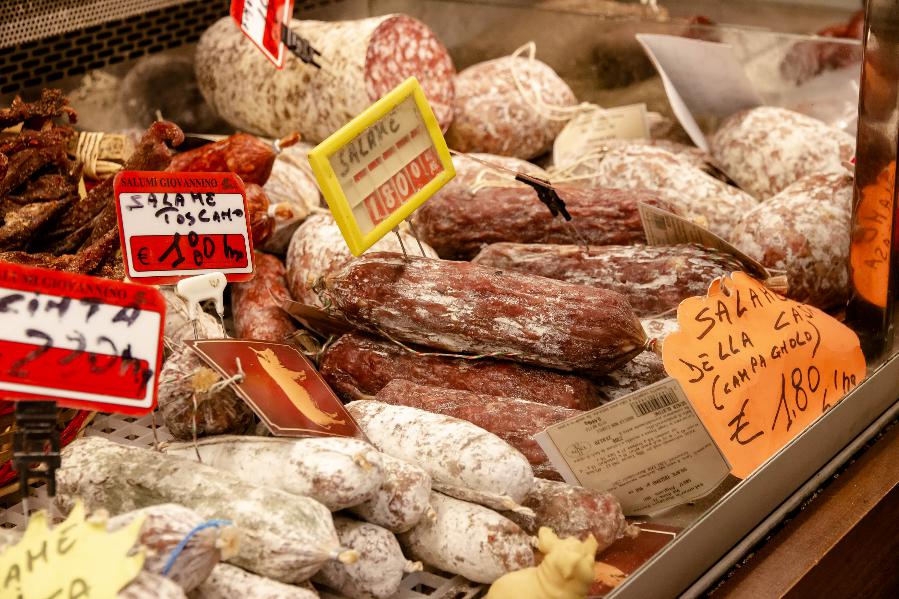Picking the best salami for pizza, of course, comes down to your personal preference.
But I can give a few quick ideas about what works best for most people after making and buying a truckload of pizza!
What is The Best Salami for Pizza?
It depends on the style of pizza and personal preference. Genoa salami is flavored with garlic and red wine for a deep flavor. Pepperoni is a preferable choice for peppery pizza. For spicy salami pizza soppressata or Picante.
As a complete salami fanatic who buys and makes salami, I can add more depth to the topic. This site is all about the passion and craft of salami and cured meat.
I’ll give more insight into what makes a decent salami and some shortcuts used in the salami-making industry.

When you’re talking about salami, you’re talking about dry-cured meat generally; it should have slowly developed flavor, making it a particular ingredient (but it can be done quickly, which is cheating more on this later, like in a few days rather than a few months).
A good salami should take about 1 to 2 months to make! (Losing moisture and intensifying the flavors).
First, I’ll dive into the quick answer and follow up later with more info.
Those are the top picks, depending on your taste buds; you can get pretty crazy flavors with additions to the tanginess like truffle, hazelnuts, figs, berries, and so much more.
If quality ingredients are used, less is more when it comes to special pizza, in my opinion (a very classic approach). When I was a student, we ‘loaded’ the pizza. It wasn’t pizza; it ended up being a pile of food on the dough, which you practically needed a big spoon to eat!
‘Italian’ Salami – it is kind of funny to see this. Since there are hundreds of Italian salamis (in Italy), it’s simple marketing to make the selection method more straightforward for the consumer.
Now, so many meats and breeds can be used for salami, as well as mixtures of straight pork or mixed with other meats like beef.
Did they use decent cuts of meat? Or leftover bits and pieces from a factory production method (Don’t get me into mechanically processed meat- scraping the bone hard).
Of course, most of the salami you’ll find in the supermarket deli will be factory-style salami, and I’ll dig into what these curtails involve a bit later. But it depends on the supermarket, so do provide local small production as well.
Salami is an exceptional occasion food for many people, even though it has been commoditized often, especially in some Western delis.
Epic and Delicious Salami for Pizza
This depends on the style of pizza.
Salami for Neapolitan Pizza:
Neapolitan pizza is known for its thin, soft, and chewy crust. It’s traditionally cooked in a wood-fired oven, resulting in a slightly charred, blistered crust.
It’s a precision pizza, with Naples Pizza being recognized through an official organisation that does months of tests and checks of the strict guidelines (even to the point of the pH acidity of the after used for the dough).
Most I’ve had in Naples have been Margherita, el Fungi (mushroom), or rocket/aragola. Topppings are just added after the based margarita has been made.
Suggested Salami:
Genoa Salami and Soppressata complement the simplicity of Neapolitan pizza with their rich, savory flavors.
Prosciutto di Parma (not salami but a cured meat, put on top after cooking the margertia based, salut!
Pan-fried Pizza:
Pan-fried pizza has a thick, crispy crust that is achieved by cooking it in a pan on the stovetop or in an oven. It’s a heartier option than Neapolitan pizza.
Suggested Salamis:
Pepperoni, Italian Sausage, and Pancetta (again, not salami but cured meat) add a burst of bold flavors and a bit of spiciness to the pan-fried pizza.
Crispy Base Pizza:
Crispy base pizza has a thin, crunchy crust that’s achieved by baking it in a high-temperature oven, creating a delightful texture contrast with the toppings.
Suggested Salamis
Chorizo, Spanish Salami, and Salami Calabrese provide a zesty and smoky kick to the crispy base pizza, enhancing the overall flavor profile.
Other Salami Pizza Tips
Cheese & Tomato + anything
Of course, when it comes to the basics of pizza, you can go any way. Most of the Western world knows classic pepperoni pizza. I prefer to use salamis without nitrates, but you can’t find those unless you look very hard.
The standard legislation in most countries requires the use of some form of nitrates/nitrites, which must be nitrates, to ensure there’s no chance of unwanted bacteria growing inside the salami.
Even many labels that say nitrate-free use an alternative like celery powder, which is full of nitrates (and the label will say nitrate-free; it’s synthetic nitrate). Nitrates are in so many vegetables that you consume daily anyway; it’s minimal for the average Joe.
Good Mold or Flour on Salami Outside

Those cheeky corporate food producers have a cunning way of making salami look like the real deal when it’s not.
A “good” white mold grows on the outside of salami and many cured meats; you’ve probably seen this. This is penicillin; just like stuff and hospitals, it’s a good mold that protects and enhances the flavor of salami.
It has a rather pleasant smell compared to fake white flour used by some factory food producers to make it look like the real deal. Or they print the white-looking mold onto the wrapping! I’ve seen this in an Italian discount supermarket too.
Tangy Acid – Fast and Slow Fermentation
Lactic acid can be added directly into a salami, which makes it shelf-stable and quick to produce and get on the shelf.
(Lactic acid happens with fermented products like sourdough bread, kimchi, and pickled veggies)
This always leads to sharp, tangy flavors and is a telltale sign of cheap dali salami.
You might also want to do some research on high heat applied to nitrates and protein meat. From what I’ve read, as long as they’re not cooked to a heated high, they are acceptable to consume. Yeah, I know. Bacon is another one that might need some research.
What is the Difference Between Salami and Pepperoni?
Well, salami is the category; pepperoni is just the type of salami. If you go back to where it came from, pepperoni is believed to be an offshoot of the Italian Picante salami.

What is Salami Fat, Spices, Acidity and Meat
Salami is a mixture of a lot of things.
Like anything, the quality of the ingredients and how it’s put together will dictate the outcome. For Sure, pay more money for good salami from a small producer, but at the same time, just remember you ingesting it and putting this food inside your body.
You are putting it IN your body – sometimes we forget this.
Traditional Vs. Modern Pizza
Pizza is traditionally a simple offering, whether it’s pepperoni or a classic Italian woodfired margarita pizza. I had the pleasure of spending quite a few months in many different regions of Italy and was lucky enough to be in Naples for the whole-picture experience.
It’s something definitely to put on your list.
Naples Pizza Experience
Classic Nepalese pizza is very nicely made and fermented with a specific type of tomato base and specific type of mozzarella cheese.
The classic Margarita.
It sounds so essential, but it blows my mind that it was done the right way and a woodfired oven.
There is a strict organization that checks all aspects, from the hard mineral content of the water to the region specifically the animals were from for the cheese – hardcore.
One option I saw in quite a few places was to put on cured prosciutto meat instead of salami, but this would be after the pizza was cooked and the cheese was melted. I recommend a margarita first.
If you wanted a pepperoni pizza in Italy, you would have to find some incredibly touristy restaurant in the middle of Rome, that’s for sure!
Nut Salami – Next Level
If you want to expand your repertoire, there are super fancy-schmancy styles. Check out the French or central European versions of salami with nuts these walnuts will be hazelnuts, and these are very interesting salamis.
Or Truffle salami, encrusted with truffles.

Tom Mueller
For decades, immersed in studying, working, learning, and teaching the craft of meat curing, sharing the passion and showcasing the world of charcuterie and smoked meat. Read More

Thank you for the information
thanks- i still enjoy sharing some thoughts after quite a few years!
Super insightful information thank you.
Can you talk more about storage and what you’ve had experience with? I like lots of different flavoured salami for my pizzas but I’m the only one that eats it in my family. I know storing “whole” salami will last longer in the fridge and depends on the use by. I am curious if perhaps I slice my entire salami’s at Purchase time, bag and freeze it. I often buy from small random producers so usually in 200-350g sizes. Too big for me to eat before expiration. Are there best practice ways to prep for frozen storage that you recommend?
What I do with bacon is slice it, freeze on non stick paper like baking paper, then bag it. Put it back in freezer. It doesnt stick together once frozen. I think if yr cooking pizza on high heat – it ‘probably’ will be fine to throw on pizza when frozen (it doesnt have much water content), or thaw for a few hrs before the pizza goes in. Thats how I would roll! 🙂 Tom
Vacpacking would be the other way but consumes alot of time and bags.